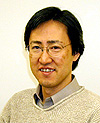Reverse Genetics: Building Flu Vaccines Piece by Piece
A new technology that's looking increasingly promising in the fight against the flu is plasmid-based reverse genetics, a procedure developed by Yoshihiro Kawaoka, Ph.D., of the University of Wisconsin, and further refined by Robert Webster, Ph.D., and Erich Hoffman, Ph.D., of St. Jude Children's Research Hospital in Memphis, TN. The technique could speed up the process by which a vaccine is created.
 |
| Yoshihiro Kawaoka, Ph.D. |
In the conventional egg method, two flu strains with the preferred features for a new vaccine are injected into an egg, and their genes reassort naturally. Researchers sift through the 250-plus possible combinations of viruses to find one that displays the desired hemagglutinin (HA) and neuraminidase (NA) antigens and is still able to grow inside an egg.
With reverse genetics, scientists can custom make a flu vaccine by assembling genes that code for the desired features. Two genes representing the HA and NA antigens are selected from the target virus, while the remaining six genes come from a virus that's time-tested for its ability to grow inside an egg. (Although the influenza virus actually uses RNA as its genetic material, the researchers make complementary pieces of DNA because DNA is easier to work with.) The DNA that codes for the viral genes is then inserted into animal cells, which make new copies of the virus. Researchers recover the resulting virus that will be used to manufacture the vaccine. Although the vaccine still needs to be grown inside eggs for large-scale production, animal cells could also be used as that technology advances.
One key benefit of the new technology is that if portions of a targeted virus, such as the H5 and H7 antigens, are too toxic to grow inside eggs, the segments of the genes coding for these antigens that make them so dangerous can be clipped and removed.
 |
| Robert Webster, Ph.D. |
Because of this characteristic, Dr. Webster and collaborators are using reverse genetics to attempt to develop a vaccine for the deadly H5N1 virus, also known as the bird flu, that has appeared in Vietnam, Thailand, and other Asian countries in winter 2003-4.
With further research, scientists will try to determine if reverse genetics technology may prove a quick and effective way for developing a suitable vaccine in the event of a pandemic.
Related Links
Publications
Non-government Web sites
back to top